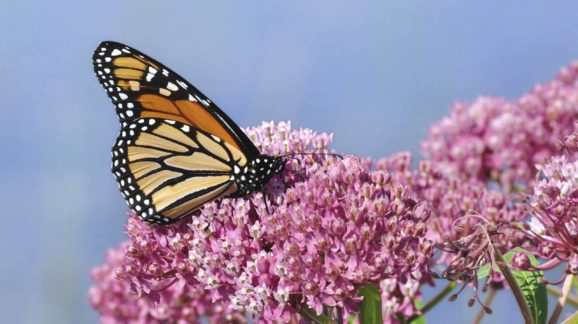Regulation Poses Biggest Threat to Monarch Butterflies

Like many nature lovers and gardeners, last year I launched a milkweed garden for monarch butterflies, starting from seed. After a long summer of manually picking pesky milkweed bugs and aphids off the plants, I noticed one monarch caterpillar. Success! I hope that caterpillar made it to the butterfly stage, and then took off to Mexico where many monarchs overwinter.
My efforts represent a tiny part of a larger effort to save these butterflies through private conservation, whose numbers have dwindled in recent decades. Such efforts may have begun to pay off as the number of monarch butterflies overwintering in Mexico this year is up! Of course, one year does not make a trend and other factor play a role such as weather. But private conservation is certainly a key element in helping this marvelous species of butterflies survive.
The Christian Science Monitor reports: “This year’s overwintering population in Mexico was: “3.5 times greater than the previous season, which saw 2.8 acres of butterflies. This is also up from the record low of 1.66 acres in 2013.” However, the number of overwintering butterflies is still 32 percent below the “historic average,” the Monitor reports.
Unfortunately, private efforts to create habitat for the butterflies could come to a halt if the federal government decides it needs to step in and list the monarch as an endangered species under the Endangered Species Act (ESA). Some environmental groups have petitioned the Department of Interior to list the species as endangered. Once a species is listed, regulations may apply to its habitat, and the costs to farmers and other property owners can be substantial. Such costs and regulations discourage people from creating and maintaining habitat for endangered species. And in extreme cases, people will destroy habitat to avoid potential regulations.
And one Texas butterfly enthusiast points out:
According to the 159-page petition’s final line, if “threatened” status is approved, such activities would be a crime. People like me and you will be allowed to raise “fewer than ten Monarchs per year by any individual, household or educational entity”–unless that activity is “overseen by a scientist, conservation organization, or other entity dedicated to the conservation of the species.”
It is ironic that an allegedly pro-species law would erode the butterfly’s habitat by potentially punishing people for creating habitat by planting and cultivating milkweed, which the butterflies need to breed. Monarch butterflies lay eggs on the milkweed, which hatch and grow into caterpillars that eat milkweed, which is poisonous. The poisons in the milkweed make the caterpillars poisonous to many potential predators.
Over the summer in the United States and Canada, these butterflies breed several generations on milkweed, with most butterflies living just a few weeks. But at the end of the summer, the last generation lives months so that it can migrate all the way to Mexico or California locations where it overwinters and then flies back north in the spring to continue the cycle.
Environmental activists blame herbicides for monarch population declines because farmers have used them to eliminate milkweed plants, but it’s not the chemicals that are the problem. Farmers need to remove all kinds of weeds—without or without herbicides—so they can plant crops to feed people. Herbicides not only make that process easier for farmers, they also reduce the need to remove weeds by tilling, which causes erosion, runoff, and soil depletion. So overall, herbicides are environmentally beneficial. And milkweed is poisonous and can kill livestock if they graze amongst it or if it gets into hay or other feed for the animals.
Farmers are not the only ones who have removed milkweed from the environment. As cities, towns, and homeowners have chosen to professionally landscape properties, many have grubbed up milkweed, which is also poisonous to humans and pets. Essentially, there was no market or demand for a plant that many people considered unsightly and that is also poisonous to people and animals. If you get the “milk” from this plant in your eye, you could blind temporarily.
The solution isn’t to blame farmers for trying to efficiently produce food or consumers who don’t want pets frolicking among poisonous plants. Rather, nature lovers need to create an appreciation for the plant and its value to butterflies, thereby promoting a market for milkweed gardens and habitat areas on or near farming, which appears to be happening.
A number of conservation groups and individuals around the nation are educating the public on the importance of milkweed, and their efforts appear to be paying off. Cities and towns are making space for milkweed along highways where its blooms offer scenic views and its poisons pose low risk. Homeowners are planting it on private property as well, where they too can manage the risks. For example, my milkweed garden lies just outside my fence, out of reach of from my three small dogs.
Let’s hope such private conservation continues and eventually thwarts efforts to list monarch butterflies under the ESA. Such listing will simply introduce perverse government policies that punish people trying to do something positive.